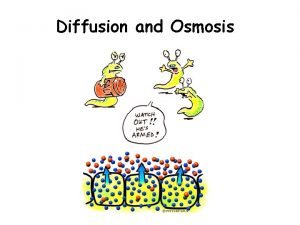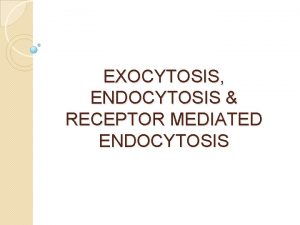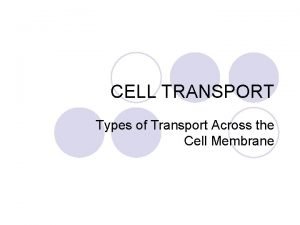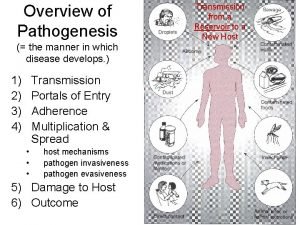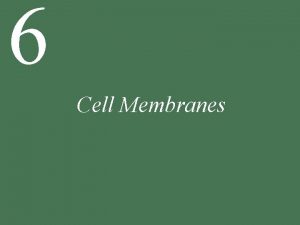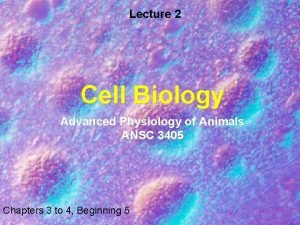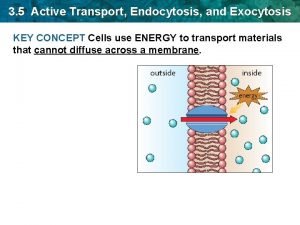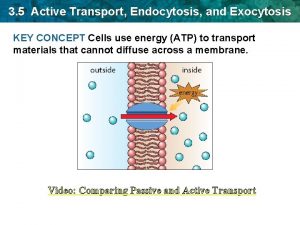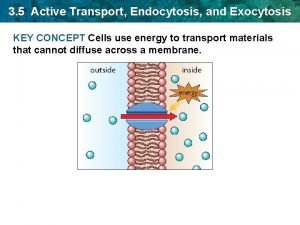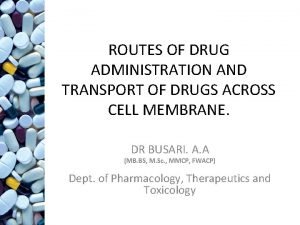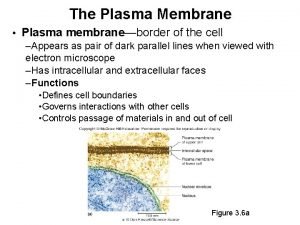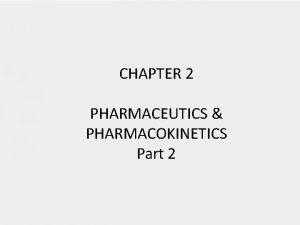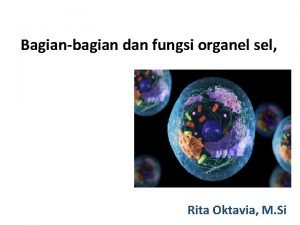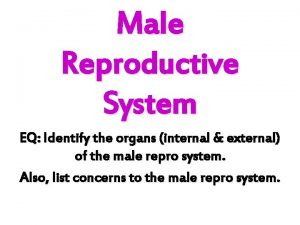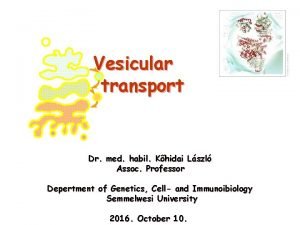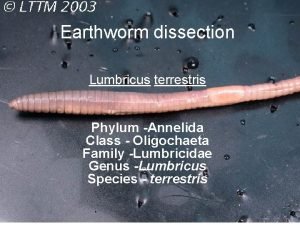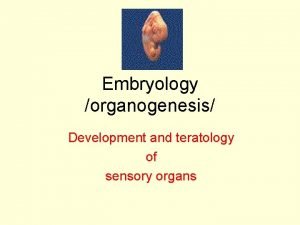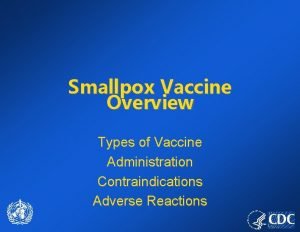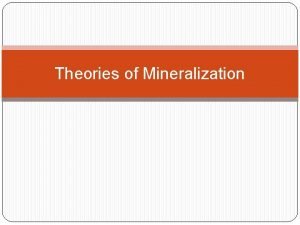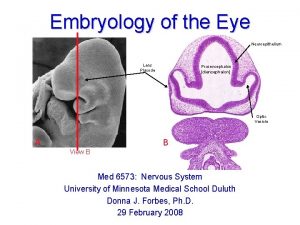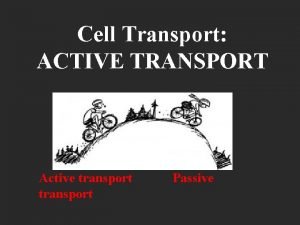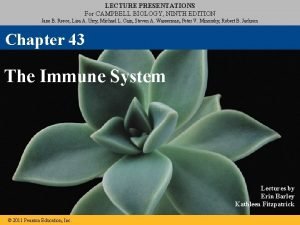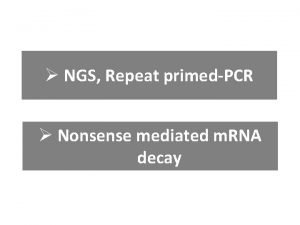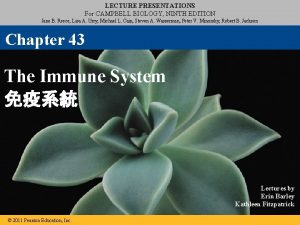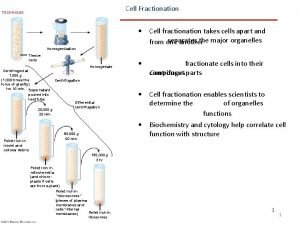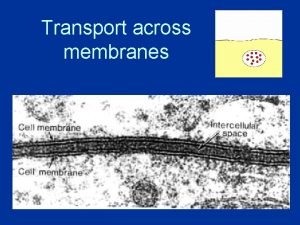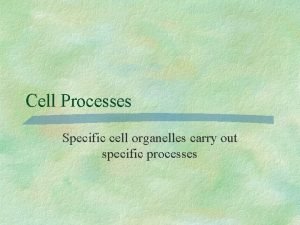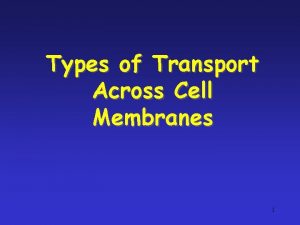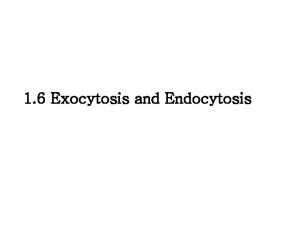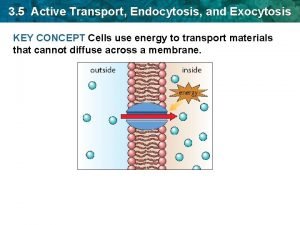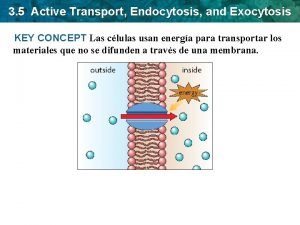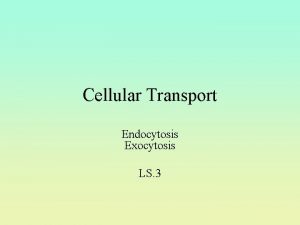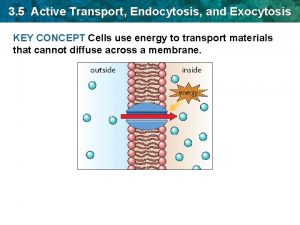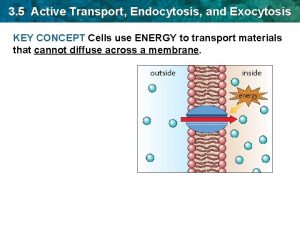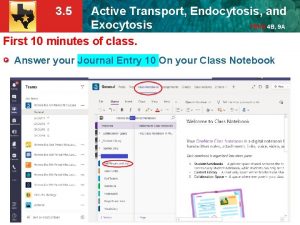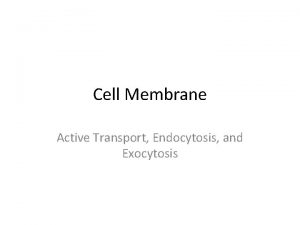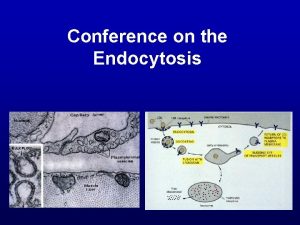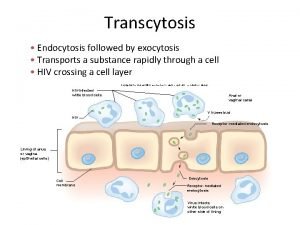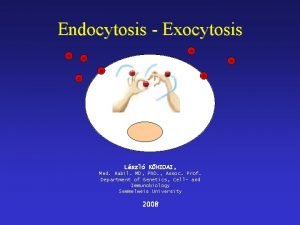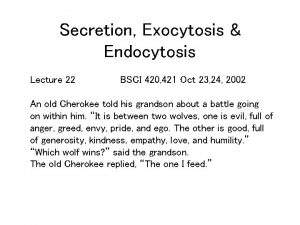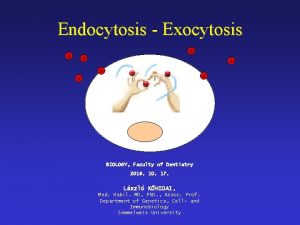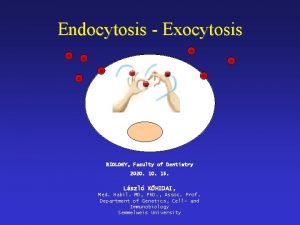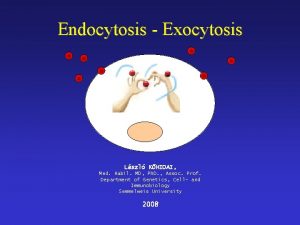EXOCYTOSIS ENDOCYTOSIS RECEPTOR MEDIATED ENDOCYTOSIS Vesicle Transport In














































- Slides: 46

EXOCYTOSIS, ENDOCYTOSIS & RECEPTOR MEDIATED ENDOCYTOSIS

Vesicle Transport � In diffusion, dissolved particles (solutes) move down a concentration gradient. � Some molecules or particles are just too large to pass through the plasma membrane or to move through a transport protein. � Cells use two other active transport processes to move these macromolecules (large molecules) into or out of the cell. � Vesicles are the bodies in the cytoplasm which help to move macromolecules or large particles across the plasma membrane.

�There are two types of vesicle transport, endocytosis and exocytosis. �Both processes are active transport processes, requiring energy.

Endocytosis: {Endo (within) cytosis (cell)} : The process by which a cell moves large amounts of material, or non-dissolved particles, into its cytoplasm from the outside environment. Exocytosis: {Exo (exit) cytosis (cell)} : The process by which large amounts of material, or large non-dissolved particles, are moved from the cell’s cytoplasm to the outside environment.


Exocytosis � Exocytosis describes the process of vesicles fusing with the plasma membrane and releasing their contents to the outside of the cell. � Exocytosis occurs when a cell produces substances for export, such as a protein, or when the cell is getting rid of a waste product or a toxin. � Newly made membrane proteins and membrane lipids are moved on top the plasma membrane by exocytosis.

� In exocytosis, membrane – bound secretory vesicles are carried to the cell membrane, and their contents are secreted into the extracellular environment. � The secretion is possible because the vesicle transiently fuses with the outer cell membrane. � Exocytosis is also a mechanism by which cells are able to insert membrane proteins (such as ion channels and cell surface receptors), lipids, and other components into the cell membrane.

Exocytotic Vesicles � Vesicles containing protein products are typically derived from an organelle called the Golgi apparatus or Golgi complex. � Proteins and lipids synthesized in the endoplasmic reticulum are sent to Golgi complexes for modification and sorting. � Once processed, the products are contained within secretory vesicles, which bud from the Golgi apparatus. � Some vesicles are formed from early endosomes, which are membrane sacs found in the cytoplasm. � These endosomes sort the internalized material (proteins, lipids, microbes, etc. ) and direct the substances to their proper destinations.

Types of Exocytosis �There are three common pathways of exocytosis. �Constitutive exocytosis �Regulated exocytosis �Lysosome pathway

Constitutive exocytosis �Constitutive exocytosis involves the regular secretion of molecules that is performed by all cells. �This pathway serves to deliver membrane proteins and lipids to the cell's surface and to expel substances to the cell's exterior.

Regulated exocytosis � Regulated exocytosis relies on the presence of extracellular signals for the expulsion of materials within vesicles. � Regulated exocytosis occurs commonly in secretory cells and not in all cell types. � Secretory cells store products such as hormones, neurotransmitters, and digestive enzymes that are released only when triggered by extracellular signals. � Secretory vesicles are not incorporated into the cell membrane, but fuse only long enough to release their contents. � Once the delivery has been made, the vesicles reform and return to the cytoplasm.

Lysosome pathway �A third pathway for exocytosis in cells involves lysosomes. �These organelles contain acid hydrolase enzymes that break down waste materials, microbes, and cellular debris. �Lysosomes carry their digested material to the cell membrane where they fuse with the membrane and release their contents into the extracellular matrix.


Steps of Exocytosis � Exocytosis occurs in four steps in constitutive exocytosis and in five steps in regulated exocytosis. These steps include vesicle trafficking, tethering, docking, priming, and fusing. � Trafficking- Vesicles are transported to the cell membrane along microtubules of the cytoskeleton. Movement of the vesicles is powered by the motor proteins kinesins, dyneins, and myosins. � Tethering- Upon reaching the cell membrane, the vesicle becomes linked to and pulled into contact with the cell membrane. � Docking- Docking involves the attachment of the vesicle membrane with the cell membrane. The phospholipid bilayers of the vesicle membrane and cell membrane begin to merge.

� Priming- Priming occurs in regulated exocytosis and not in constitutive exocytosis. This step involves specific modifications that must happen in certain cell membrane molecules for exocytosis to occur. These modifications are required for signaling processes that trigger exocytosis to take place. � Fusion- There are two types of fusion that can take place in exocytosis. � In complete fusion, the vesicle membrane fully fuses with the cell membrane. The energy required to separate and fuse the lipid membranes comes from ATP. The fusion of the membranes creates a fusion pore, which allows the contents of the vesicle to be expelled as the vesicle becomes part of the cell membrane. � In kiss-and-run fusion, the vesicle temporarily fuses with the cell membrane long enough to create a fusion pore and release its contents to the exterior of the cell. The vesicle then pulls away from the cell membrane and reforms before returning to the interior of the cell.

Exocytosis Examples � Exocytosis is used by a number of cells in the body as a means of transporting proteins and cell to cell communication. In the pancreas, small clusters of cells called islets of Langerhans produce the hormones insulin and glucagon. � These hormones are stored in secretory granules and released by exocytosis when signals are received. � When glucose concentration in the blood is too high, insulin is released from islet beta cells causing cells and tissues to take up glucose from the blood. � When glucose concentrations are low, glucagon is secreted from islet alpha cells. � This causes the liver to convert stored glycogen to glucose. � Glucose is then released into the blood causing blood-glucose levels to rise. � In addition to hormones, the pancreas also secretes digestive enzymes (proteases, lipases, amylases) by exocytosis.

Endocytosis • Endocytosis is the case when a molecule causes the cell membrane to bulge inward, forming a vesicle. • Endocytosis is a form of active transport in which a cell transports molecules (such as proteins) into the cell by engulfing them in an energy-using process. • The three types of endocytosis are: Receptor mediated endocytosis Phagocytosis Pinocytosis

Receptor mediated endocytosis � Receptor-mediated endocytosis (RME), also called clathrin- mediated endocytosis, is a process by which cells absorb metabolites, hormones, other proteins – and in some cases viruses – by the inward budding of plasma membrane vesicles containing proteins with receptor sites specific to the molecules being absorbed. § Endocytotic mechanism in which specific molecules are ingested into the cell. § The specificity results from a receptor-ligand interaction.

Receptor mediated endocytosis §The protein Clatherin coats the inside of the membrane in the area of the pit. §Receptors on the plasma membrane of the target tissue will specifically bind to ligands on the outside of the cell. §An endocytotic process occurs and the ligand is ingested. §Two chemical compounds called Pitstop 1 and Pitstop 2, selective clathrin inhibitors, can interfere with the pathogenic activity, and thus protect the cells against invasion.

Clathrin � Clathrin is a protein that plays a major role in the formation of coated vesicles. � Clathrin was first isolated and named by Barbara Pearse in 1976. � It forms a triskelion shape composed of three clathrin heavy chains and three light chains. � They form a polyhedral lattice that surrounds the vesicle.

Steps Of Receptor Mediated Endocytosis Step 1: 1 Ligand binds to membrane receptor. Extracellular fluid Receptor Intracellular fluid

Step 2 1 Ligand binds to membrane receptor. 2 Extracellular fluid Receptor-ligand migrates to clathrin-coated pit. Clathrincoated pit Receptor Clathrin Intracellular fluid

Step 3 1 Extracellular fluid Ligand binds to membrane receptor. 2 Receptor-ligand migrates to clathrin-coated pit. Clathrincoated pit 3 Endocytosis Receptor Clathrin Intracellular fluid

Step 4 1 Extracellular fluid Ligand binds to membrane receptor. 2 Receptor-ligand migrates to clathrin-coated pit. Clathrincoated pit 3 Endocytosis Receptor Clathrin 4 Vesicle loses clathrin coat. Intracellular fluid

Step 5 1 Extracellular fluid Ligand binds to membrane receptor. 2 Receptor-ligand migrates to clathrin-coated pit. Clathrincoated pit 3 Endocytosis Receptor Clathrin 4 5 Endosome Receptors and ligands separate. Vesicle loses clathrin coat. Intracellular fluid

Step 6 1 Extracellular fluid Ligand binds to membrane receptor. 2 Receptor-ligand migrates to clathrin-coated pit. Clathrincoated pit 3 Endocytosis Receptor Clathrin 4 5 To lysosome or Golgi complex 6 Ligands go to lysosomes or Golgi for processing. Endosome Receptors and ligands separate. Vesicle loses clathrin coat. Intracellular fluid

Step 7 1 Extracellular fluid Ligand binds to membrane receptor. Receptor-ligand migrates to clathrin-coated pit. 2 Clathrincoated pit 3 Endocytosis Receptor Clathrin 7 Transport vesicle with receptors moves to the cell membrane. 4 5 To lysosome or Golgi complex 6 Ligands go to lysosomes or Golgi for processing. Endosome Receptors and ligands separate. Vesicle loses clathrin coat. Intracellular fluid

Step 8 1 Receptor-ligand migrates to clathrin-coated pit. 2 8 Extracellular fluid Ligand binds to membrane receptor. Transport vesicle and cell membrane fuse (membrane recycling). Clathrincoated pit 3 Endocytosis Receptor Clathrin 7 Transport vesicle with receptors moves to the cell membrane. 4 5 To lysosome or Golgi complex 6 Ligands go to lysosomes or Golgi for processing. Endosome Receptors and ligands separate. Vesicle loses clathrin coat. Intracellular fluid

Last Step 1 9 8 Extracellular fluid Ligand binds to membrane receptor. Exocytosis Receptor-ligand migrates to clathrin-coated pit. 2 Transport vesicle and cell membrane fuse (membrane recycling). Clathrincoated pit 3 Endocytosis Receptor Clathrin 7 Transport vesicle with receptors moves to the cell membrane. 4 5 To lysosome or Golgi complex 6 Ligands go to lysosomes or Golgi for processing. Endosome Receptors and ligands separate. Vesicle loses clathrin coat. Intracellular fluid

Diagrammatically explanation 1 9 8 Ligand binds to membrane receptor. Exocytosis Extracellular fluid Receptor-ligand migrates to clathrin-coated pit. 2 Transport vesicle and cell membrane fuse (membrane recycling). Clathrincoated pit 3 Endocytosis Receptor Clathrin 7 Transport vesicle with receptors moves to the cell membrane. 4 5 To lysosome or Golgi complex 6 Ligands go to lysosomes or Golgi for processing. Endosome Receptors and ligands separate. Vesicle loses clathrin coat. Intracellular fluid

Uptake of cholesterol • The uptake of cholesterol by mammalian cells has provided a key model for understanding receptor-mediated endocytosis at the molecular level. • Cholesterol is transported through the bloodstream in the form of lipoprotein particles, the most common of which is called low-density lipoprotein, or LDL. • The uptake of LDL by mammalian cells requires the binding of LDL to a specific cell surface receptor that is concentrated in clathrin-coated pits and internalized by endocytosis.

W h a t is p h a g o c y t o s i s It is defined as ingestion of particles of >0. 5µm by cells.

• Phagocytosis is one type of endocytosis that occurs when a cell uses its membrane to bring non - dissolved particles or solid particles into its cytoplasm. • In phagocytosis, the cell extends finger-like projections of its cell membrane, called pseudopods, around a piece of solid material outside of the cell. • The pseudopods that surround the solid object eventually join to form a vacuole with in the cells cytoplasm. • The cell then releases chemicals into the vacuole. • The chemicals digest the solid particle into smaller particles that may be used for energy or building material. • Phagocytosis is also often called “cell eating”.

Who discovered p h a g o c y t o s i s ? • Ellie Ilya Metchnikoff discovered it in 1882. • Received Nobel prize for the same in 1906 • Carl Fredrich Claus coined the term Phagocytosis.

Solid material is taken into the cell in a vesicle.

Examples WBC remove bacteria and cell debris.

Amoeba engulfs food

Cells involved - Professional phagocytes- have specific receptors 1. Neutrophils 2. Monocytes 3. Macrophages 4. Dendritic cells 5. Mast cells 6. Eosinophils


No. N P r o f e s s i o N a l s Phagocytosis is not their main function , do not have specific receptors. �Lymphocytes �NK and LGL cells (Large Granular lymphocytes) � Epithelial cells Endothelial cells Fibroblasts

How does i t w o r k Entry of the pathogen Phagosomes Phagolysosomes Recruitment of phagocytes & inflammation

di a g r a m

Pinocytosis • Pinocytosis is another form of endocytosis in which small particles are brought into the cell, forming an invagination and then suspended with in small vesicles and then it breaks down the particles. • Pinocytosis works just like phagocytosis but the only difference other hand, pinocytosis is when the cell engulfs already-dissolved or broken-down food. • Pinocytosis is also known as “cell drinking”.

Diagram

Example Human egg cell taking up nutrients from surrounding cells.

 Receptor - mediated endocytosis
Receptor - mediated endocytosis Receptor-mediated endocytosis
Receptor-mediated endocytosis Hypostonic
Hypostonic Receptor mediated endocytosis
Receptor mediated endocytosis Receptor - mediated endocytosis
Receptor - mediated endocytosis Receptor - mediated endocytosis
Receptor - mediated endocytosis Exocytosis
Exocytosis Is exocytosis active or passive
Is exocytosis active or passive Unlike passive transport active transport requires
Unlike passive transport active transport requires Exocytosis
Exocytosis Parenteral route advantages and disadvantages
Parenteral route advantages and disadvantages Carrier mediated transport
Carrier mediated transport Carrier mediated transport
Carrier mediated transport Exocytosis active or passive transport
Exocytosis active or passive transport What is cell drinking
What is cell drinking Fungsi secretory vesicle
Fungsi secretory vesicle Seminal vesicle in earthworm location
Seminal vesicle in earthworm location Seminal duct
Seminal duct Penile urethra
Penile urethra Vesicle fusion
Vesicle fusion Annelida
Annelida Coelomic epithelium
Coelomic epithelium Recessus tubotympanicus
Recessus tubotympanicus Eczema vaccine contraindication
Eczema vaccine contraindication Similarities between male and female reproductive system
Similarities between male and female reproductive system Acrosomal vesicle
Acrosomal vesicle Seeding theory of mineralization
Seeding theory of mineralization Seminoma
Seminoma Optic vesicle diencephalon
Optic vesicle diencephalon Exocytosis
Exocytosis Golgi apparatus exocytosis
Golgi apparatus exocytosis Exocytosis active or passive
Exocytosis active or passive Mediator vs. moderator variable
Mediator vs. moderator variable Cell mediated immunity
Cell mediated immunity Nonsense mediated decay
Nonsense mediated decay Nonsense mediated decay
Nonsense mediated decay Exocytosis
Exocytosis Membrane synthesis
Membrane synthesis Cell mediated immunity
Cell mediated immunity Exocytosis
Exocytosis Positive vs negative reinforcement
Positive vs negative reinforcement Socially mediated positive
Socially mediated positive 3 types of active transport
3 types of active transport Integral and peripheral proteins
Integral and peripheral proteins Mediated values essay examples
Mediated values essay examples Agrobacterium mediated gene transfer
Agrobacterium mediated gene transfer Pinocytosis
Pinocytosis
